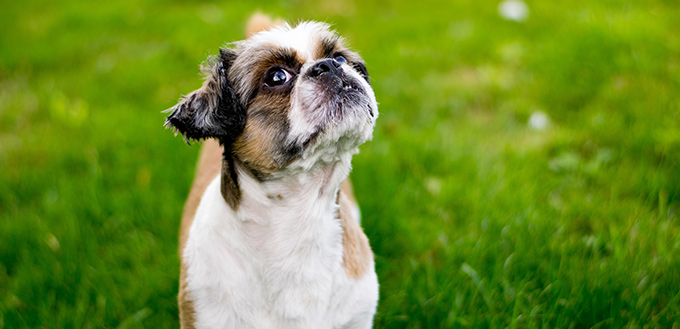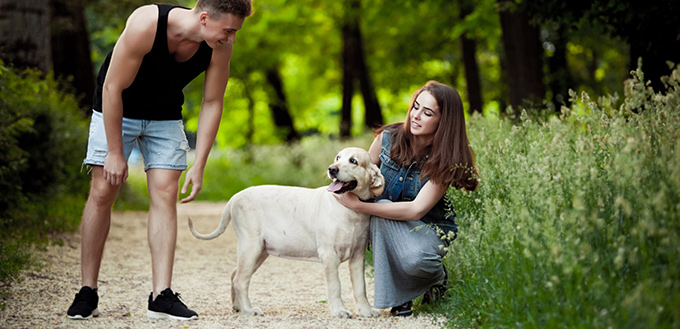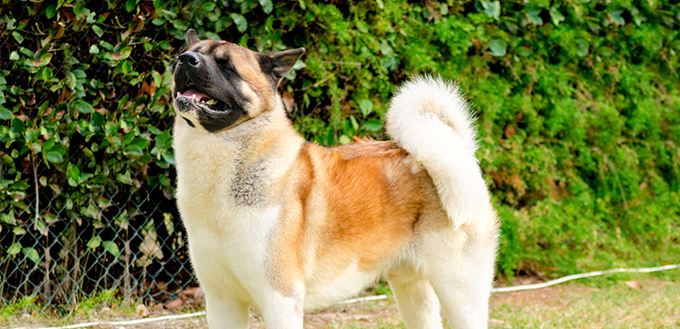Is your dog shy or fearful around new situations or people? This is for you. Having a shy dog can make it challenging to experience new things or go to new places together. However, worry not, because there is a lot you can do to boost your pet’s confidence.
When someone says they have a “nervous” or “shy” dog, you might misinterpret what they mean by this statement. We tend to assume that shyness in dogs is similar to that of a human being, but it is not the case. Unlike shy people who are usually docile in public, shy dogs express their unease in an aggressive way. Dog owners who are unprepared to handle the situation might take it personally, but it isn’t. Unfortunately, some dog guardians who do not understand what this means might end up abandoning their canine friends.
What Makes Dogs Fearful?
The first step to helping your furry friend boost their confidence is figuring out the root of the anxiety. Usually, shy and nervous dogs have been through neglect, abuse or any other traumatic experience. Understanding the reason behind shyness will help you know the right tactics to use.
How Do I Tell That My Dog is Fearful?
Before taking steps to boost your dog’s confidence, the first step is determining whether they are fearful or not by checking their body language. It is most apparent when your dog shows signals of fear, such as a tucked tail, shaking, avoidance and trying to hide. Additional signs to look out for include lip licking, dropping his tail, panting, crouching and shaking off.
If your dog is terrified, they might become overly aggressive, in a bid to make the source of fear to disappear. When you modify your pet’s behavior, remember that these tips will only work if your pet is slightly shy or fearful. If the fear is too high, consider getting professional assistance.
How to Boost Confidence in Your Dog
If your canine friend does not respond to these tips or responds aggressively, do not shy away from getting expert assistance.

1. Start With Exposure Management
This tip might sound fancy, but it isn’t. Exposing your dog is a way of rewiring his brain to associate something he was once scared of with something good. Let’s say your pet was afraid of skateboards, and you want to drive the fear away from him. You can sprinkle the skateboard with treats and place it on the floor. After a while, the dog will inspect the board and realize that it might be moving away with the gifts. Therefore, he will want to get close to it so that he can enjoy the goodies.
After the dog is comfortable getting close to the stationary skateboard, you can move it for a short distance while the treats are on the board. Once the dog does not fear the moving skateboard, you can move it a few inches more. Continue increasing the inches with which you move the board until he copies what he will find in real life – a moving skateboard with someone at its top.
This tip will help to recondition your pet’s response by managing the exposure (so that your dog doesn’t react to the same thing constantly) and then introducing a stimulus (the thing that your dog is scared of). The technique should be controlled and linked to positive experiences such as food. For it to be efficient, make sure that the gift is of high value, such as hot dog and pieces of cheese.
2. Take Up Agility Training
Agility training entails teaching your pet tasks such as running through a plastic tube and jumping over a pole. Train him in a way that he can complete the tasks in a certain order. Even though your dog is learning other skills, this exercise is all about trust.
You should start doing these activities in a gentle, appropriate manner so that your dog can learn cues from their human friend. With time, your canine buddy will know that all they have to do is listen to their friend and whatever you tell them will be awesome.
When your dog manages to complete the new obstacles successfully, your dog will gain more trust in himself and you too. You will be surprised to know the things that your dog can do once you start expanding other parts of his life.

3. Use Targeting
Targeting is training your dog to touch a particular part of his body to achieve a specific result. The reason for this trick is to keep your pet focused on you even when he is in the presence of a person or thing that is scaring him. It’s a simple trick to teach, and most dogs catch on fast.
Start by holding a treat in your hand. The dog will sniff your hand because of the nice smell coming from it. This is known as nose targeting, and you have to do it a few times. Eventually, your dog will get the idea that if he bumps his nose into your hand, he will get a reward.
Next, change the tactic. When they sniff your hand, don’t give them a trick. Instead, take their paw in your other hand and place it on the closed fist; as you instruct him to touch. Now give them the treat. After your dog can respond to these cues, they will have learned a valuable lesson. Make it fun and change the gifts regularly.
You may use the commands any time he requires to be distracted from something that might be disturbing him. The end game is for him to associate the uneasy experience of a person with a positive result of getting a treat. That way, he will not be troubled with the thing that is causing him distress.
Any time your dog gets nervous, try playing the touch game. So, next time you are out, and he encounters a scary thing, tell him “touch” and he’ll stop being scared. The game will keep him engaged, and he will be happy to play it.
4. Allow Your Dog to Spend Time with Other Dogs
You may not realize this, but allowing your dog to spend time with other dogs can go a long way in boosting their confidence. Dogs who are open to these kinds of interactions will admire the other dog’s behavior. Once they see another dog trying something they fear, they might be like, “I have to try this, it seems fun.” Over time, your dog will be able to do things that they never thought they would.
Unfortunately, this approach works on sure dogs only. Its success will also depend largely on your pet’s personality as well as that of the dog he is introduced to. That is why you should consider taking him to dogs that are more confident than he is.
The technique works best when introduced to your dog during a tender age. Consider starting when the dog is about eight weeks old. Make the visits regular. That way, your dog will be not only confident but also social.
5. Find an Environment Where Your Dog Can Be Successful
Sitting at home and concentrating on what could be wrong is not beneficial for your mind or your dog. If you can find an environment that makes him happy, go for it, it might be the best way of enhancing his confidence.
For instance, you can go hiking in locations where your dog likes spending more time. If the environment fascinates him, and there is an array of cool scents, your dog will not be bothered about what scares him. On the contrary, he will concentrate on the sights and smells.
This technique will help your pet to spend less time being anxious and more time exercising his curiosity. However, this approach may not go well with your dog. Some dogs might be uncomfortable in environments such as the wilderness. If your dog is not happy in the background, avoid taking him there, and instead find somewhere he is comfortable staying.
The idea is that you should not allow your dog to spend a lot of time practicing problem habits. Avoid such situations by all means. That is how you can reprogram. Show your lovely dog that the thing that scares them is not that scary, that big, that loud, or that close.

6. Consider Obedience Training
In most cases, fearful dogs become more confident once their lives are structured. A shy dog is likely to be upset by anything that is not part of his usual routine. Your dog can benefit a lot from obedience training in that he gets the predictability he wants in life.
Teaching your dog new skills such as how to come, how to sit and how to lie down is essential in boosting confidence for two reasons. The first one is that it enables you to create a language with your dog, something that is instrumental in regards to teaching the successful dog behaviors. After you develop a suitable language through both body language and commands, you gain direct control over the dog’s behavior. That way, you will be able to communicate with your dog when she is feeling fearful.
The second reason why this is helpful is that you will build trust between you and your canine friend. Gaining your dog’s confidence is a critical factor in making her more confident in the home environment. Understanding obedience training will also help you to direct your canine friend easily, even when she is anxious or worried. That way, your furry friend will get over the things that scared her.
7. Treat and Retreat
“Treat and retreat” is a great way of helping dogs to become braver. Start with what your dog considers being a safe distance from the thing or person they are scared of. Ask the person to throw a low value treat. Your dog is likely to go for it happily. Next, let them throw a treat of a much higher value. The dog will turn around to keep the individual in view.
Let your helper continue the exercise. The treat he throws should be of a higher value than the previous one. With time, the dog starts relaxing, and your helper will continue closing up the distance between him and your dog.
This technique requires patience. If you go too fast, your dog might freak out, and she will not want to take the treat, even when it is of a higher value than the last one. Your end goal should be ensuring that your dog is comfortable taking the treat from the person he deemed scary. Eventually, he will want to be brave enough because he can associate his bravery to the nice things that the person is doing for him.
8. Start Far When Introducing New Things
Dogs have a certain level of stress when facing a new person or situation. You will realize that the more they approach the situation, the more scared they become. Whenever you are working with a fearful dog, it is vital to be cautious so that you don’t cross the threshold too fast. Let your dog overcome his fears of the person from a distance before making your way to it slowly.
As you get closer to the stimuli, you will notice that you cannot divert your pet’s attention. Most dogs will not even take a treat at this time. That is why you should always start from a distance, even during obedience training. That way, your dog can focus on your instructions because getting too close scares them.
Once you get too close to the object and your dog is unable to concentrate on you, you will have to move back. Take time to observe how near to the object your dog can get. That way, you will understand what works for the dog.
You can use all these strategies for your dog until you find one that works best for him. Although every guardian hopes that their dog will become well-socialized and well adjusted, some dogs take longer than others. Every dog’s journey is different, so allow yours enough time to thrive.
Sources:
- Terri Bright, Ph.D., How to Build Puppy Confidence, The MSPCA-Angell
- Building Confidence in Dogs, Best Friends Animal Society






